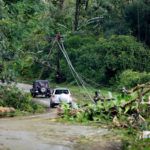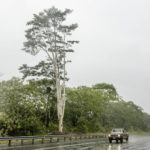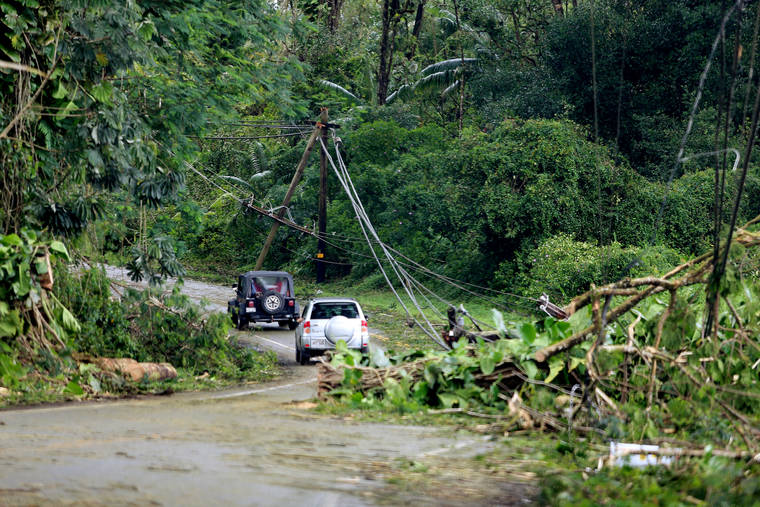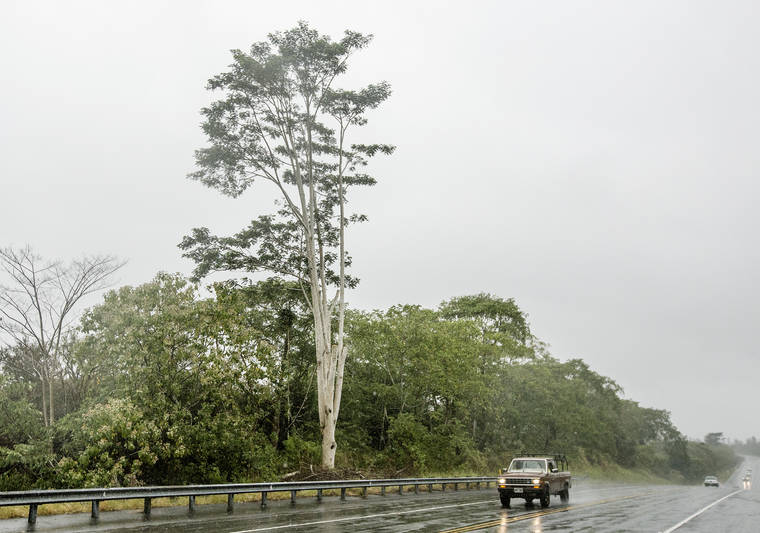With new law in effect, albizia fight continues


A spokeswoman for the Big Island Invasive Species Council said the first explorers of a new law allowing landowners to remove potentially dangerous albizia trees from neighboring properties could be community associations in Puna.
Albizia, an invasive species that grows tall quickly but has shallow roots, is prone to shedding heavy limbs. The destructive winds of Tropical Iselle, which hit the Big Island in early August 2014, toppled albizias like matchsticks. The resulting fallen trees and limbs blocked roads, damaged homes and downed utility lines, causing power, telephone and cellular communication outages.
ADVERTISING
The concern over albizia could again come to the fore as Hawaii is in the midst of a hurricane season that has already seen seven named storms and four hurricanes in the Central and Eastern Pacific.
BIISC spokeswoman Franny Kinslow Brewer said Friday the community associations of three subdivisions in particular, Kalapana Seaview Estates, Ainaloa Estates and Leilani Estates, have been especially proactive in terms of combating albizia.
“We reached out to them after Iselle and we did this with communities throughout Puna and said, ‘If you’re interested, we will come out there to work with you and train everybody. And we will have volunteer days where we come out there and work side by side.’ Lots of communities took us up on our initial offer but (Seaview and Ainaloa) took it to the next level,” said Kinslow Brewer. “We provided support but the communities went out of their way to organize this.
“… Leilani was doing this before the eruption where they were trying to take care of the albizia … and just last month, we went out there and started working with them again. They’re starting up their community organization on albizia again.”
According to Leilani Community Association President Andy Andrews, albizias remain a concern in the subdivision just outside Pahoa. He added, however, that the invasive trees are a lower priority than lava recovery, squatters in abandoned properties and tourists entering the private subdivision to witness the devastation caused by last year’s lower East Rift Zone eruption of Kilauea volcano.
“We did have a small but very active group of people who were proactively going out. On lots where there was nobody, they would go onto a lot and typically just poison the albizia with the Milestone,” Andrews said, referring to a brand of herbicide used to kill the trees. “And on lots where there was a known owner, they would get permission to go in, some even that had homes on them.”
Senate Bill 464, introduced by Sen. Russell Ruderman of Puna, with the backing of fellow Big Island Democratic Sens. Lorraine Inouye, Kai Kahele and Dru Kanuha plus Oahu Democrat Gil Rivere, became a law July 1 without the signature of Gov. David Ige.
Under the law, landowners who want to remove albizias on neighboring properties that could present a threat to their own properties must consult a “tree risk assessment qualification certified arborist” to confirm the tree is potentially dangerous and can be safely removed. Then, the landowner seeking removal of the trees must make two or more reasonable attempts to contact the neighboring property owner within 30 days and provide written notice to the neighboring landowner.
Then, if the concerned landowner receives no response from the neighboring landowner, the concerned landowner will be authorized to enter the neighboring property and treat the tree with herbicides.
The landowner seeking removal of trees is to bear all costs of the removal.
“The costs to take down these trees are amazing high … $10,000, $20,000, $30,000 to take some of the most giant trees down,” Andrews said. “On the other hand, here in Leilani, we don’t have nearly the problem with it that HPP does or some of the other subdivisions. The albizias here were not permitted to get quite as out of hand. And then, our worst infestation of albizia — which was almost dead center in our subdivision — was in an area that burned years ago in a brush fire that went through and killed some of some of the smaller vegetation and the albizias. This was a long time ago, 20 years ago. That area is now covered by lava.
“And then, the biggest albizias were taken out by the lava flow.”
Andrews said there are still a “couple of pockets” in Leilani where albizias “seem to propagate from a central point and then grow out from there.”
“There are a couple of spots — way down towards the bottom of what’s left of Kahukai Street and … right along Leilani Avenue there are still some big beasts of trees,” he said.
While the fast-growing but fragile trees pose a potential threat to properties adjacent to those they occupy, according to Andrews, attempting to remove them could trigger another set of issues aside from the expense of an arborist.
“Part of the problem with poisoning the trees is that they start to break up. You’ve ended the problem longterm but you’ve actually exacerbated the problem longterm because now you’ve got these massive limbs that are threatening to drop as the tree dies,” he said.
Kinslow Brewer said the communities most likely to take advantage of the new law have “sort of hit a wall with removing albizia they had property owner permission for.”
“They’re looking to utilize it to get unto those last remaining absentee-owner properties they haven’t been able to get before,” she said.
“Unfortunately, there’s one little piece that kind of throws a monkey wrench into it. They have to get an arborist to certify that the trees are not going to be a hazard to treat right now, that they can treat it safely. And so, if you’re not hiring an arborist to take down the tree, you just want them to come and look at little 10-foot and 15-foot trees, it’s hard to get somebody out there.
“It’s so much cheaper to do it when those trees are young and to take a half-hour, maybe a couple of hours, depending on the size of the property, to take care of those trees so the neighbors don’t have to worry about it.”
Email John Burnett at jburnett@hawaiitribune-herald.com.






